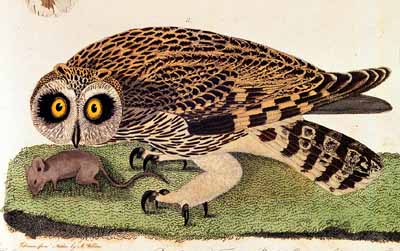
Hand-colored plate from American Ornithology, v.4 by Wilson, Alexander, published by Porter and Coates, Philadelphia, no date.
Illinois State Museum collection
Short-eared Owl
(Asio flammeus)
Interesting facts:
A Short-eared Owl can be identified in flight by its pale gray underwing with a black wrist mark. It also moves its wings much like a butterfly does.
Description:
The Short-eared Owl gets its name from its very small tufts--the two bunches of short feathers that stick out near the top of the head. Its facial disk is round with few markings, except black rims around the eyes. Its bill is black and its eyes are yellow. The body, which is 11 to 13 inches long, has shades of brown and buff feathers, with streaks on its back.
Habitat:
The Short-eared Owl migrates through Illinois but rarely nests there. It travels through the state in spring and comes back in October and November, some staying the winter. It may nest as far north as northern Canada. It lives in fallow fields and marshy areas and may roost in short trees near their hunting areas.
The female lays 4 to 8 round white eggs on bare ground among tall grass and reeds. The eggs take about 26 days to hatch, and the young leave the nest from 30 to 40 days later.
Food:
Short-eared Owls hunt small mammals such as mice, voles, woodrats, and muskrats. They also eat small birds and insects. These owls can be seen hunting at dawn and dusk.
Status:
In Illinois, the Short-eared Owl is an endangered species because of habitat destruction and intensive farming practices.